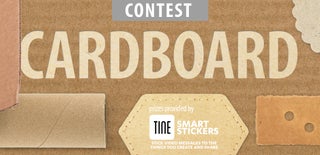Introduction: Cardboard Quadcopter.
Can you make a quadcopter out of Cardboard? you can if you reinforce it with fibreglass!
This is a little experiment (it has nothing to do with the fact there is a competition for cardboard and one for drones!) the idea was to make a quadcopter body from cardboard and then add a couple of layers of fibreglass to give it some strength.
This turned out to be a very quick build.
Attachments
Step 1: Designing the Shape and Cutting Out the Cardboard.
So as normal i used my tried and trusted method of designing the craft on my raspberry Pi using QCAD. then i save the design as a PDF which i can print and share on here.
Once i had completed the design of one of the arms i printed it out 4 times on paper and using cellotape stuck them together to make sure the angles were correct and the motors and propellers were ok. once i was happy with the design i then cut the 4 arms out of cardboard. Now i should point out that the corrugated cardboard i used was cut from a high quality box and was very rigid and the 3 layers were very close. Also it didn't have any printed information on it which may have made a difference to how the fibreglass set.
So you can see in the photos i cut out the sections using a scalpel and steel rule. Then the 4 arms were creased along the fold lines and the ends taped using masking tape to hold the arms in the correct shape. Next the 4 arms were stuck together using a square of cardboard underneath the 4 ends with double sided sticky tape.
Step 2: Mounting the Structure on the Wood.
So the next stage is to stick the model to a solid base, and in my case i have a peice of 3/4" ply wood. It was import before sticking any thing down that the model was going to be square, so i marked out the wood and then placed two pieces of masking tape across so i could line up the center of each arm.
So you can see in the photo i have used a piece of double sided tape and stuck the arm down on the line, and i have also gone over the edges with masking tape.
Once i had got all 4 corners down i then needed to do something with the sides of the arms as they could move and would have been pushed around when i rolled the fibreglass. So i measure up the area between the two arms and cut the section out of cardboard again this was just held in place with double sided sticky tape.
Then i finished of around all the edges using masking tape.
Step 3: Fiberglass.
So this step is mainly covered in the video, but i will also describe it here.
I have used two layers of 180 cloth (180 grams per square meter) and in between the two layers of cloth i have used a layer of tissue. I have used the tissue between because the cloth shouldn't be put on top of each other, normally you would use Chop Strand Mat (CSM) in between, but i have run out and it's a lot heavier at 300 grams per square meter and requiring 2.5 times the weight of the CSM of resin to wet it out. Cloth on the other hand (and tissue) only requires a ratio of one to one, which means you need the same weight of resin as you have cloth. i didn't even measure out the weight of resin as i have loads spare and if i don't use it then it will go off in the can.
So the first step once you have mixed up the resin with hardener is to give the cardboard a good coat of resin.Then drape over the cloth and using a paint brush stipple the cloth down with resin, you shouldn't brush the cloth as you will end up moving it around and may get folds or creases. Once that layer is "wetted out" i then added the tissue and quickly went over that layer with the brush again, then finally i added the second layer of cloth but this time i placed the cloth at an angle of about 45 degrees to the first layer and again brushed resin into the cloth.
When the whole model was wet with resin i then rolled over the model (carefully, its only cardboard) using a special fiberglass roller. this helps to push all the bubbles out and push the resin through the cloth (consolidate it) you can see the resin being pushed out and sometimes you may have too much resin which you can brush off and scrape back into the tub.
You can see in one of the pictures that i had problems with the corners, so if i make another model like this i will put a radiused fillet in the corners.
Step 4: Cutting Out and Adding the Hardware.
Once the fibreglass had set (overnight as i didn't put enough hardener in) i removed the model from the wood board by using a hacksaw blade. this turned out to be the best way to do it as i tried a diamond disc in a multi tool but it just kept getting jammed.
When it was cut free i then went over the edges with a piece of sandpaper to get rid of the sharp edges.
Then i drilled and mounted the 4 motors, i found it easier to drill the holes by using one of the motor mounts as a template (don't forget to drill a hole in the middle to clear the motor shaft). Make sure you drill the holes the correct way as two are one a bigger radius than the others, and when i screwed the motors down i used cut down motor mounts as big washers to stop the screws pulling into the card.
Next to be mounted were the ESC's which were just stuck down with foam tape, then i added the power distribution board in the middle and soldered all the power wires to it.
Then i added the KK Flight control board on top of the power board using m3 "Stand off's" before i screwed this down i powered it up to get the correct direction form the show motor layout option. once i was happy with the layout i screwed it down and connected all the ESC control wires (just follow the motor layout diagram)
And the receiver and a battery and thats it! This was one of the quickest builds i have ever done!
I test flew the model before lunch on the second day, the first day was about an hour of preparing and fiberglassing, then i let it set overnight and the next day finished building the model in the morning. SO QUICK!
And once i have a play with the PID settings it should fly very nicely.

Runner Up in the
Drones Contest 2016

Third Prize in the
Cardboard Contest 2016














